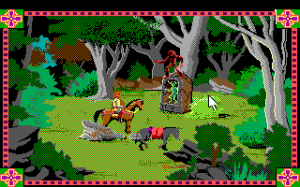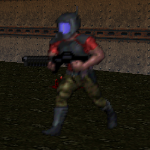This is something I’ve been hoping for ever since sierra adventures started appearing on GoG. They now have Conquests of Camelot! You take on the role of King Arthur, seeking the holy grail in a mission to restore the fortunes of his Kingdom. You must also find three of the knights of the round table, who went missing in their own attempts to find the grail.
My original review is here – I guess I’ll be mostly saying the same things today. It’s long been my favourite of the Sierra family, in fact one of my top adventures of all time. There are a couple of reasons I didn’t bring it up in our “top DOS games” articles recently (part1, part2); for one thing, it’s fairly obscure. Also I wouldn’t say its puzzles are the greatest. At least three of the big ones just quiz you for information in the manual, so they’re basically little more than copy protection.
Still, this the adventure that made the greatest impression on me, because there is something intriguing, compelling, about the places it takes us. We are shown a mythical version of the Dark Ages, where mysterious sorcerers practise arcane arts, and supernatural entities lurk in the wildernesses and dark places. Magic is something that peasants fear and even a King must treat with respect.
The first half of the game takes place within Arthur’s kingdom, as you follow the trail of Launcelot and Galahad. You journey through a perilous forest encountering mischevious spirits, hostile wildlife and the mysterious Black Knight. Later you explore ancient ruins haunted by angry, forgotten gods. You must also visit the Lady of the Lake; for some reason she’s currently very unhappy, and has used her magics to cast her domain into the depths of an unnatural winter.
Later your travels take you to the holy land. After a trek across the desert, you find yourself on the dusty streets of Jersualem. You’re no revered king here, just a traveller. Who’s broke and a bit ignorant of local customs. Here you spend a lot of time talking to shopkeepers about the price of donkeys and buying household items. It sounds mundane but this actually one of the game’s best sections of genuine puzzle solving.
There are again mystical forces at work behind the scenes in Jerusalem, as you meet the servants of an ancient goddess, one known by many names over the centuries. Her days are coming to an end, and this is a running theme throughout the game. Old, pagan powers are slowly fading, while Christianity claims worshippers and expands its influence.
The game is stuck in 16-colour EGA, but I generally find the artwork good enough to surpass that technical limitation. It’s clean and colourful with clearly differentiated themes like the green and browns of the forest, or the pristene white and blue of the frozen lake. The general sense of atmosphere is also greatly boosted by the soundtrack by Mark Siebert. He was also using fairly basic technology, the humble adlib card, yet did some great work with it. The music carries across various themes like the glory of Camelot, the somber nobility of your quest for a holy relic, or the relief of finding a well after a long trek across the desert.
Perhaps the one way the Camelot disappoints me relates to the map screen of southern Britannia. This indicates over a dozen locations to visit. Each promises an opportunity to explore more of the Kingdom, and learn some more about the legends of Arthur Pendragon. Then you realise you can only travel to about four places; click any other and the game just tells you there’s nothing relevant there. So we get to see rather less of these lands than is first suggested.
To be fair this section comprises only half the content of Conquests. I’m not sure how its overall length compares to other adventures of the time; maybe it’s quite average. Still, since I found this game so captivating, I would have been happy for it to last an hour or two longer.
Looking to a more practical matter, this being one of those early SCI games, you can only use the mouse to walk around. To interact with stuff or talk to anyone, you’ll have you have to type in text commands to talk to people or interact with stuff.
Since this is a Sierra game you can die, and probably will do a lot. Just save often. There’s also the possibility of putting yourself in a situation where you can keep playing but it’s impossible to win, which in old adventures could actually more frustrating than dying. Here’s a hint: take the right sort of money with you on your quest, or you’ll be stuck several hours later. If I recall right, most other mistakes of this nature are fairly easy to avoid. Like, you can leave your knights to die if you find them, but you’re meant to be a champion of virtue, you bastard. It won’t go well for you.
There are a bunch of action sequences, which were sometimes jarring and unwelcome in adventures, but I figure you’re a sword-wielding warrior, so they’re not totally inappropriate. There’s a section fighting off rampaging boars which is kind of a chore, but a short while later they made a brave effort at a first-person view jousting simulator. There’s also an epic battle at the end that I found genuinely intense, two warriors of very different cultures duelling in the dust of a fallen empire.
One more high point is the snarky commentary from Merlin, who serves as the game’s narrator . The idea is he’s using his magic psychic powers to watch over and communicate with you. Sometimes he offers advice, others he gives scathing commentary (and the occasional bad pun) about the way you’ve managed to get yourself killed.
So then, I’ve acknowledged a bunch of flaws here, but Conquests of Camelot will always be particularly important to me. It’s possible I’m just super nostalgic about it. Still, I think it offers something different to the rest of the Sierra stable at least, an actual epic quest instead of twee sanitised fairytales or goofy humour. I reckon it’s worth $7 to adventure fans, anyway.
Oh also, remember Jem from the 80s? That cartoon about an all-lady glam rock band? Funnily enough this was written by the same person, Christy Marx.




 Posts
Posts
I’ve never heard of this game before and didn’t see your old review. I think I’ll grab it from GOG, sounds like it could be fun. Guess you don’t get commission!
May 9, 2017 @ 1:14 pm
Hope you enjoy it!
May 26, 2017 @ 4:38 pm
Also just to confirm we don’t have any affiliate arrangements in place with GOG or anyone else. Even though we’re always mentioning them!
May 26, 2017 @ 6:18 pm